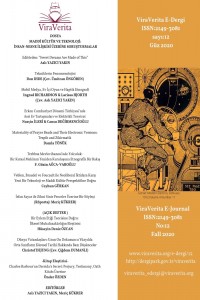Abstract
Çalışma, eski Doğu Almanya’nın küçük bir kasabası olan Doberlug-Kirchhain’daki Trebbus Mevlevihanesi’ne etnografik bir bakış yöneltmektedir. Yıllar önce Müslüman olarak Berlin’den Halep’e uzanan bir güzergâhta manevi bir yolculuğa çıkan Halis Efendi, Halep Mevlevihanesi’ndeki üstadının isteği üzerine doğup büyüdüğü Almanya’ya geri dönerek, Trebbus Mevlevihanesi’ni kurmuştur. Çalışmanın ana sorusu, tekkenin kutsal mekân olarak kuruluşu ile Halis Efendi’nin yolculuklarından edindiği deneyimlerle bağlantılı nesnelerin ilişkisinin nasıl olduğudur. Yirmi birinci yüzyıl Almanya’sında tasavvufi bir deneyim mekânı olan tekkenin iç düzenlemesi, eşya ve kutsal mekân ilişkisini sergilemektedir. Çoğunluğu kendisi gibi mühtedilerden oluşan dervişleri ile Halis Efendi anlatının temsilcisi ve yeniden kurucusudur. Anlatının, kurucu nesneler ve ritüeller yoluyla nasıl vücut bulduğu oldukça dikkat çekicidir. Mevlevihane başka zaman ve mekânlara açılan bir ‘sonsuza dek biriken zamanlar heterotopyası’dır. Makale Almanya’da İslam çalışmalarının görünmeyen yüzlerinden olan sufi mühtedilerin mekânsal aidiyetlerinin arka planına ve kutsal mekânın nostaljik yeniden kuruluşunda nesnelerin rolüne dair fikir vermektedir.
References
- Baudrillard, J. (2011). Nesneler Sistemi. (O. Adanır& A. Karamollaoğlu, Çev.). İstanbul: Boğaziçi Üniversitesi Yayınevi.
- Benjamin, W. (1991a). Der Erzähler: Betrachtungen zum Werk Nikolai Lesskows.In R. Tiedemann & H. Schweppwnhäuser (Eds.), Walter Benjamin: Gesammelte Schriften II (S. 438-465). Frankfurt am Main: Suhrkamp Verlag.
- ____________(1991b). Erfahrung und Armut. In R. Tiedemann & H. Schweppwnhäuser (Eds.), Walter Benjamin: Gesammelte Schriften II (S. 213-219). Frankfurt am Main: Suhrkamp Verlag.
- ____________(1992) Pasajlar. A. Cemal (çev.). İstanbul: Yapı Kredi Yayınları.
- ____________(2007). Erzählung und Heilung. In A. Honold (Eds.), Erzählen: Schriften zur Theorie der Narration und zur literarischen Prosa (S. 197-198). Frankfurt am Main: Suhrkamp Verlag.
- Boym, S. (2009). Nostaljinin Geleceği. (F. B. Aydar, Çev.). İstanbul: Metis Yayınları.
- Eliade M. (1959). The sacred and the profane; the nature of religion. New York: Harcourt Inc.
- Foucault, M. (2016). Özne ve İktidar. (I. Ergüden, Çev.). İstanbul: Ayrıntı Yayınları.
- Gündüzöz, G. (2017). Tasavvufta Tâc Sembolizmi. İstanbul: Büyüyen Ay Yayınları.
- Gürbilek, N. (2020). İkinci Hayat: Kaçmak, kovulmak, dönmek üzerine denemeler. İstanbul: Metis Yayınları.
- Karaman, Y. (2018). Benjamin, Foucault Ve Heterotopya . FLSF Felsefe ve Sosyal Bilimler Dergisi, 13 (26), 267-286.
- Rudolf, B. (2007). Heimweh und Nostalgie. In K. Busch & I. Därmann (Eds.), “Pathos”. Konturen eines kulturwissenschaftlichen Grundbegriffs. (S. 103-118). transcript Verlag.
- Schütz, A. (1972). Der Heimkehrer. In A. Brodersen (Eds.) Gesammelte Aufsätze II (S. 70-85). Den Haag: Martinus Nijhoff.
- Stewart, S. (2007). On Longing: Narratives of the Miniature, the Gigantic, the Souvenir, the Collection. Duke University Press.
A Journey in the Trebbuser Mevlevihane: An Ethnographic Insight into the Reconstruction of a Sacred Space
Abstract
This study provides an ethnographic insight into Trebbuser Mevlevihane (Mevlevi lodge) in Doberlug-Kirchhain, a small town in the former East Germany. Once upon a time, after converting to Islam, Halis Efendi took a spiritual journey from Berlin to Aleppo. Following his master’s order in Aleppo, he later returned to Germany, where he was born and raised, and established the Trebbuser Mevlevihane there. The main question of this study is how Halis Efendi's experiences and the objects linked to these experiences are related to the reconstruction of tekke (sufi lodge) as a sacred space. The interior setting of the tekke, which is the space of Sufi experience in the twenty-first-century Germany, displays the relationship between belongings and the sacred space. Halis Efendi is the representative and reconstructor of the narrative together with his dervishes, most of whom are converts to Islam like himself. The way the narrative manifests itself through constituent objects and rituals is quite striking. Mevlevihane is a ‘heterotopia of indefinitely accumulating time’ opening up to other times and spaces. This article gives an idea about the background of the spatial belonging of the Sufi converts, one of the invisible faces of Islamic studies in Germany, and the role of objects on the nostalgic reconstruction of sacred space.
References
- Baudrillard, J. (2011). Nesneler Sistemi. (O. Adanır& A. Karamollaoğlu, Çev.). İstanbul: Boğaziçi Üniversitesi Yayınevi.
- Benjamin, W. (1991a). Der Erzähler: Betrachtungen zum Werk Nikolai Lesskows.In R. Tiedemann & H. Schweppwnhäuser (Eds.), Walter Benjamin: Gesammelte Schriften II (S. 438-465). Frankfurt am Main: Suhrkamp Verlag.
- ____________(1991b). Erfahrung und Armut. In R. Tiedemann & H. Schweppwnhäuser (Eds.), Walter Benjamin: Gesammelte Schriften II (S. 213-219). Frankfurt am Main: Suhrkamp Verlag.
- ____________(1992) Pasajlar. A. Cemal (çev.). İstanbul: Yapı Kredi Yayınları.
- ____________(2007). Erzählung und Heilung. In A. Honold (Eds.), Erzählen: Schriften zur Theorie der Narration und zur literarischen Prosa (S. 197-198). Frankfurt am Main: Suhrkamp Verlag.
- Boym, S. (2009). Nostaljinin Geleceği. (F. B. Aydar, Çev.). İstanbul: Metis Yayınları.
- Eliade M. (1959). The sacred and the profane; the nature of religion. New York: Harcourt Inc.
- Foucault, M. (2016). Özne ve İktidar. (I. Ergüden, Çev.). İstanbul: Ayrıntı Yayınları.
- Gündüzöz, G. (2017). Tasavvufta Tâc Sembolizmi. İstanbul: Büyüyen Ay Yayınları.
- Gürbilek, N. (2020). İkinci Hayat: Kaçmak, kovulmak, dönmek üzerine denemeler. İstanbul: Metis Yayınları.
- Karaman, Y. (2018). Benjamin, Foucault Ve Heterotopya . FLSF Felsefe ve Sosyal Bilimler Dergisi, 13 (26), 267-286.
- Rudolf, B. (2007). Heimweh und Nostalgie. In K. Busch & I. Därmann (Eds.), “Pathos”. Konturen eines kulturwissenschaftlichen Grundbegriffs. (S. 103-118). transcript Verlag.
- Schütz, A. (1972). Der Heimkehrer. In A. Brodersen (Eds.) Gesammelte Aufsätze II (S. 70-85). Den Haag: Martinus Nijhoff.
- Stewart, S. (2007). On Longing: Narratives of the Miniature, the Gigantic, the Souvenir, the Collection. Duke University Press.
Details
| Primary Language | Turkish |
|---|---|
| Journal Section | Articles |
| Authors | |
| Publication Date | November 20, 2020 |
| Submission Date | August 15, 2020 |
| Published in Issue | Year 2020 Issue: 12 |


